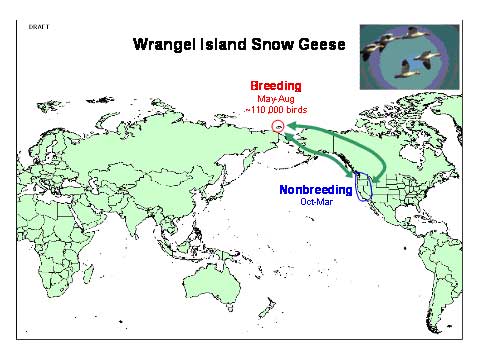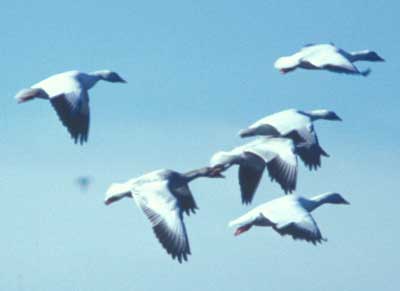Lesser Snow Goose, Chen caerulescens caerulescens
High-Priority Species ListWrangel Island snow geese may become exposed to the Asian H5N1 virus from other waterbirds that winter in Asia and nest or molt on Wrangel Island. Exposure to Asian H5N1 may also occur among snow geese that stop over on the north coast of the Chukotka Peninsula during autumn migration, where they could come in contact with a variety of species that may carry the virus from winter or migration sites in Asia or Siberia. Transmission of the virus within this population may be rapid because they nest colonially, rear goslings on a common brood-rearing area, and congregate in large flocks during migration and winter. Exposure of North Slope snow geese to Asian H5N1 may occur when they intermingle with Wrangel Island geese on wintering areas, or if some Wrangel Island birds that are carriers of the virus disperse to the North Slope for breeding. Snow geese marked at Wrangel Island have been captured at some North Slope nesting colonies.
Sampling of subsistence harvested birds will require much cooperation from local hunters on the YKD. To facilitate cooperation, the subsistence HPAI working group will develop outreach material on Asian H5N1 for distribution to local hunters. The flyer will describe in English and Yupik how the Asian H5N1 virus spreads among migratory birds, which species on the YKD are strongest candidates for carrying Asian H5N1, transmission of the virus from birds to humans, procedures hunters can follow to diminish their likelihood of contracting the virus, and the importance of sampling harvested birds for presence of the virus. During the spring and summer of 2006, the Yukon Delta NWR will distribute flyers to villages, provide information on the virus to local people, and request assistance from hunters. Refuge personnel will also be trained to obtain and preserve cloacal or tracheal swabs from hunter-shot birds, but the majority of the subsistence harvested snow geese will be sampled by sub-contractors. Age (juvenile versus adult plumage) of sampled birds should be recorded. Samples will be returned to the USFWS coordinator who will transfer samples to the National Wildlife Health Center. The number of subsistence-harvested birds sampled will depend on hunting efforts and success of local people, and the ability to collect samples.
Sampling for Asian H5N1 in snow geese on the North Slope will occur when birds are captured during molt in July as part of ongoing marking efforts led by Alaska Biological Research, Inc (ABR). ABR plans to capture snow geese on the Ikpikpuk River Delta in July 2006. In past years they have captured approximately 1,100 individuals at that site. Cloacal swabs will be collected from about 100 adult and 100 juvenile snow geese of both sexes. USGS will provide 1-2 individuals to assist with sampling.
The most efficient, least expensive means of obtaining samples from Wrangel Island Snow Geese would be to capture geese on Wrangel Island during on-going banding operations. Due to the remoteness of the field site, samples will be stored in alcohol, which will still provide very useful samples (Hon Ip, USGS, pers. com). Sampling vials and media could be delivered to Russian scientists attending the Pacific Flyway meeting in Oregon during March. Importation permits will be required to get the samples back into the country.
No. of samples: Total 400, including 200 birds from brood flocks on Wrangel Island, Russia, 200 from brood flocks on the North Slope, and 100 sampled opportunistically from subsistence hunters.
Sampling locations: Samples will be collected from brood flocks on Wrangel Island and on the Ikpikpuk River Delta, Alaska. Additional samples will be obtained from subsistence hunters on St. Lawrence Island, and on the YKD, Alaska.
Sampling timeframe: Geese will be sampled during July and August on Wrangel Island and on the North Slope. Subsistence harvest on St. Lawrence Island and the YKD generally occurs in September.
Sample demographics: An equal sample of adults and young will be taken from brood flocks, whereas all susbsistence-harvested birds encountered will be sampled for Asian H5N1.
Methods of capture: Brood flocks will be herded into standard drive traps on Wrangel Island, and the North Slope of Alaska. Subsistence-harvested birds will be sampled by hunters in local villages.
Other targeted species: It may be possible to obtain samples from other high-ranking species during brood drives on Wrangel Island and when conducting subsistence harvest surveys.
Contact: Fred Broerman
Alaska Biological Research, Inc. (Sampling of North Slope snow geese)
Ely, C. R., Takekawa, J. Y., and M. L. Wege. 1993. Distribution, abundance, and productivity of Wrangel Island Lesser Snow Geese Anser caerulescens during autumn migration on the Yukon-Kuskokwim Delta, Alaska. Wildfowl 44:24-32.
Mowbray, T. B., F. Cooke, and B. Ganter. 2000. Snow Goose (Chen caerulescens). In The Birds of North America, No. 514 (A. Poole and F. Gill, eds.). The Birds of North America, Inc., Philadelphia, PA.
Takekawa, J.Y., Orthmeyer, D.L., Kurechi, M., Sabano, Y., Syroechkovsky, E.V., Litvin, K.E., Baranyuk, V.V. & Andreev, A.V. 1994. Restoration of lesser snow geese to east Asia: a north Pacific rim conservation project. Trans. N. Am. Wildl. & Natur. Resour. Conf. 59: 132-145.

Ranking Score: 15.0
Asian H5N1 ranking criteria for Lesser Snow Goose, Chen caerulescens caerulescens.
Total of partial contact with Asia1 |
Contact with known "hot spot"2 |
Habitat used in Asia3 |
Pop. in Alaska4 |
Can samples be obtained? |
Score |
5.0 |
1.0 |
4.0 |
3.0 |
2.0 |
15.0 |
The Wrangel Island colony of 110,000 breeding birds is managed as a discreet population |
No known use of AI-infected areas |
Freshwater marshes, ephemeral wetlands |
Entire breeding population of 110,000 breeding birds plus young of the year migrate through Alaska enroute to the west coast states |
Could be difficult to obtain target number depending on timing and route of migration |

